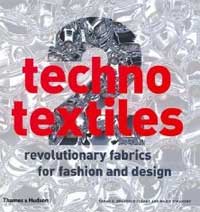 Techno Textiles: Revolutionary Fabrics for Fashion and Design No. 2, by Sarah E. Braddock Clarke and Marie O’Mahony (USA and UK)
Techno Textiles: Revolutionary Fabrics for Fashion and Design No. 2, by Sarah E. Braddock Clarke and Marie O’Mahony (USA and UK)
Editors’ blurb: Techno Textiles 2 explores an exciting area of art, design and technology that defines our 21st-century way of life. Here are new textiles for fabrics that shrink or expand to fit; textiles developed from carbon, steel, glass and ceramics; materials that protect the wearer from every environmental extreme, anywhere on earth or in space.
Part 1 of the book reviews innovation in textiles. Part 2 examines how fashion designers, product designers, architects and artists are using these innovations. Contrary to my expectations the first part was absolutely brilliant and the second from which i was expecting loads of fun was so-so.
Part 2. I won’t comment on the chapter dedicated to fashion designers as i’ve never managed to be really interested in fashion, unless it’s extreme, edgy, signed by Walter van Beirendonck, or has no regard to practicality. The same goes for design. However the textile and design chapter revealed a few surprises. The section started with classics such as carbon fibre table and Marcel Wanders‘s Lace Table then drifted to more spectacular works like CellTran‘s Myskin biological bandages made from patients own skin cells to Tissue Culture & Art Project’s Semi-Living Seamless Jacket. The section about textile and architecture was fairly good, with some examples of “smart” materials, temporary and mobile structures and a few examples of inflatable structures. The art chapter was a bit too traditional for my taste. Actually the best art bits were spashed all over the Part 1 of Techno Textile.
Part 1, dedicated to innovations, is a feast that unveals many possibilities for a new appraoch to materiality. It includes chapters dedicated to The Future of Fibres and Fabrics, Electronic Textiles, Engineered Textiles and Textiles Finishes. It is packed with easy-to-swallow technical information and illustrates it with plenty of examples of how development in textile is influenced by the necessity to adapt to extreme environment, allergies to electromagnetic waves or the “cyborg age”: extract of seaweed microencapsulated into fabrics, interactive pillows, Urine Collection Devices for astronauts, Stelarc’s Ping Body, the International Fashion Machines, etc.
Now for the project i discovered (in this case re-discovered) through this book: it’s the Audio Jacket, a pioneering work by Benoit Maubrey.
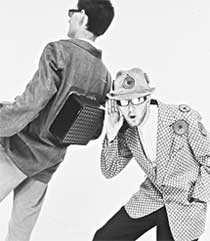
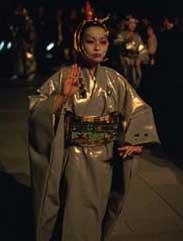 Audio Jacket and Audio Geisha
Audio Jacket and Audio Geisha
In 1982, Maubrey started sewing loudspeakers to second-hand jackets. The first prototypes were equipped with portable cassette players and 10-watt amplifiers. Turned into into mobile loudspeaker systems, the jacket were playing prerecorded cassettes. The idea was then applied to a series of “Audio Uniforms”, suits for men and women equipped with a loudspeaker-corset inside the jacket and an amplifier mounted on the back. Seven people wearing these uniforms performed in various cities where the sounds of the suits were adapted into different urban landscapes: for example, pedestrian traffic signals were used to choreograph the uniforms at a major street intersection in Hamburg and parallel escalators were used to dictate their movements in an indoor shopping mall in Munich.
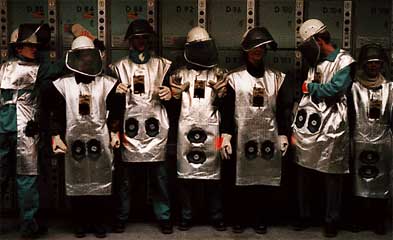 Audio Steelworkers
Audio Steelworkers
Some of the most spectacular variations on the Audio Jacket included 10 electro-acoustic uniforms based on the fireproof clothes worn by the workers in the local steelmills, the sounds were recorded at the local steel plant. The uniforms were then used to amplify a concert by Hans Peter Kuhn in Linz, for the 1986 Ars Electronica festival. In 1997, in cooperation with the Japanese performance group “Venus Show” Maubrey worked on Audio Geishas. Four Japanese performance artists were equipped with Audio Kimonos complete with guitar amplifiers, digital memories, solar powered radio receivers, and microphones.
Some of the artist’s latest works: Audio Peacocks, wearable electronic instruments made of polycarbonat plexiglass and equipped with 16 loudspeakers, amplifiers, and batteries. The “audio-plumage” functions like an electroacoustic radar dish. An Audio Peacock can either amplify its own electronic instrument and voice or receive sounds from outside sources via transmitter/receiver and disseminate them in a space by orienting his high-tech “plumage”.
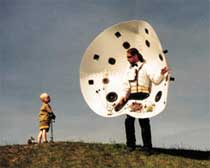
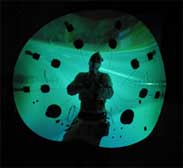 Audio Peacock and Video Peacock
Audio Peacock and Video Peacock
The video version of the Audio Peacock costume is used as a mobile projection screen in an concert where moving images (both live and recorded) can be projected directly onto the performer’s costume. A story is told “live” by a figurant who simultaneously samples his own amplified voice, manipulating the sound (loop and pitch). Video (via.)
Other works by Benoit Maubrey: the Audio Igloo and the Audio Ballerinas.
